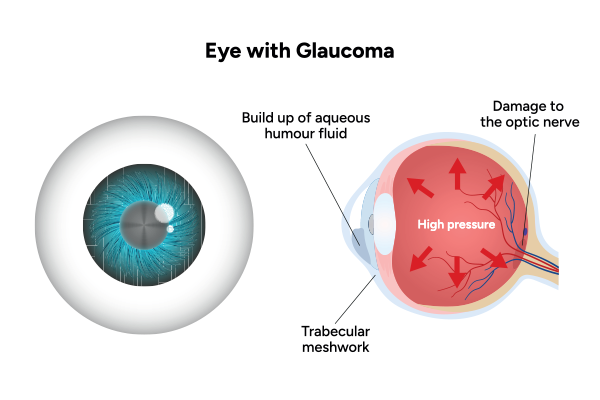
Glaucoma is one of the leading causes of irreversible blindness worldwide. It affects millions of people, often progressing silently until significant vision loss occurs. Understanding this eye condition is crucial for early detection and effective management. In this blog, we will explore what is glaucoma, its causes, symptoms, risk factors, and how to prevent it. We will also highlight World Glaucoma Day, its significance, and how global awareness efforts can help curb this vision-threatening disease.
Synopsis
What is Glaucoma?
Glaucoma is a group of eye diseases that damage the optic nerve, which is essential for clear vision. The damage is often caused by abnormally high pressure in the eye (intraocular pressure or IOP). If left untreated, it can lead to permanent vision loss or blindness.
There are different types of glaucoma, with the most common being:
-
Primary Open-Angle Glaucoma (POAG): A slow-progressing form that often goes unnoticed until vision is affected.
-
Angle-Closure Glaucoma: A sudden increase in eye pressure that can cause severe pain and immediate vision loss.
-
Normal-Tension Glaucoma: Damage to the optic nerve occurs despite normal eye pressure levels.
-
Congenital Glaucoma: A rare form that occurs in infants due to abnormal eye development.
More reads: Know Everything about Burning eyes

Why Does Glaucoma Occur?
Glaucoma primarily develops due to increased intraocular pressure. The eye produces a fluid called aqueous humor, which normally drains out through a structure known as the trabecular meshwork. When this drainage system is blocked or functions improperly, fluid accumulates, increasing eye pressure and causing optic nerve damage. Several factors contribute to glaucoma, including:
-
Genetic predisposition
-
Age (higher risk after 40)
-
Diabetes and hypertension
-
Prolonged use of corticosteroids
-
Eye injuries or surgeries
Is Glaucoma Hereditary?
Yes, genetics play a significant role in glaucoma. If a close family member has glaucoma, your risk of developing the condition increases. Regular eye check-ups are essential, especially if there is a family history of the disease.
What Are Early Signs of Glaucoma?
Glaucoma is often called the "silent thief of sight" because it can progress unnoticed. However, some early symptoms may include:
-
Gradual loss of peripheral vision (tunnel vision)
-
Eye pain or pressure
-
Halos around lights
-
Redness in the eye (especially in angle-closure glaucoma)
Early detection through routine eye exams can help prevent irreversible damage.
How to Prevent Glaucoma?
While glaucoma cannot always be prevented, certain lifestyle choices and proactive steps can reduce the risk:
-
Regular Eye Exams: Early detection through comprehensive eye tests is the best defense against glaucoma.
-
Control Blood Pressure and Diabetes: These conditions contribute to increased eye pressure and nerve damage.
-
Exercise Regularly: Moderate exercise can help regulate eye pressure and improve circulation.
-
Avoid Excessive Screen Time: Prolonged exposure to digital screens can strain the eyes, indirectly affecting overall eye health.
-
Use Protective Eyewear: Protecting your eyes from injury can prevent secondary glaucoma.
-
Maintain a Healthy Diet: Foods rich in antioxidants, omega-3 fatty acids, and vitamins A, C, and E support eye health.
More reads: Know Everything about Puffy Eyes
Can Glaucoma Be Reversed?
Unfortunately, glaucoma-related vision loss is irreversible. However, treatments can slow or halt disease progression. These include:
-
Medications: Prescription eye drops help reduce intraocular pressure.
-
Laser Therapy: Procedures like trabeculoplasty improve fluid drainage.
-
Surgery: In severe cases, surgical options like trabeculectomy or drainage implants are recommended.
World Glaucoma Day and Its Significance
When is World Glaucoma Day?
It is observed annually on March 12 to raise awareness about the disease and its impact. The initiative aims to educate people about early detection, prevention, and treatment.
Each year, the World Glaucoma Day Theme focuses on a specific aspect of awareness and prevention. The global campaign encourages eye screenings, public discussions, and medical advancements to combat glaucoma-related blindness.
Glaucoma Types and Their Characteristics
To make the information more interactive, here is a table summarizing the different types of glaucoma:
|
Type of Glaucoma |
Cause |
Symptoms |
Treatment Options |
|
Primary Open-Angle Glaucoma |
Slow blockage of drainage canals leading to increased eye pressure |
Gradual vision loss, no early symptoms |
Eye drops, laser therapy, surgery |
|
Angle-Closure Glaucoma |
Sudden blockage of drainage canals |
Severe eye pain, nausea, blurred vision |
Emergency treatment, laser therapy |
|
Normal-Tension Glaucoma |
Optic nerve damage despite normal eye pressure |
Gradual vision loss |
Monitoring, eye drops, surgery if needed |
|
Congenital Glaucoma |
Abnormal development of eye drainage system |
Cloudy eyes, excessive tearing, light sensitivity |
Surgery, medication |
Conclusion
If you are concerned about your eye health or have a family history of glaucoma, don’t wait! Visit Manipal Hospital for comprehensive eye screenings, expert diagnosis, and advanced glaucoma management. Book an appointment today to protect your vision and prevent irreversible damage.
Your eyesight matters—prioritize regular check-ups and early detection. Schedule your consultation with an expert Ophthalmology at Manipal Hospital, Jaipur now!
FAQ's
People over 40, those with a family history of glaucoma, diabetics, and individuals with high blood pressure or high eye pressure are at higher risk.
Yes, if left untreated, glaucoma can lead to total vision loss. However, early diagnosis and treatment can help preserve vision.
Adults over 40 should have an eye exam every 1-2 years. Those at high risk may need more frequent screenings.
Lifestyle changes like a healthy diet, regular exercise, reducing caffeine intake, and staying hydrated can help maintain normal eye pressure. However, medical treatments are necessary for managing glaucoma effectively.
Yes, congenital glaucoma can affect infants and young children, though it is rare. It requires immediate medical intervention to prevent vision impairment.



















 5 Min Read
5 Min Read









